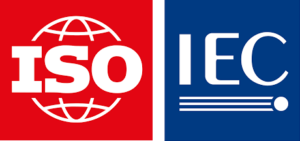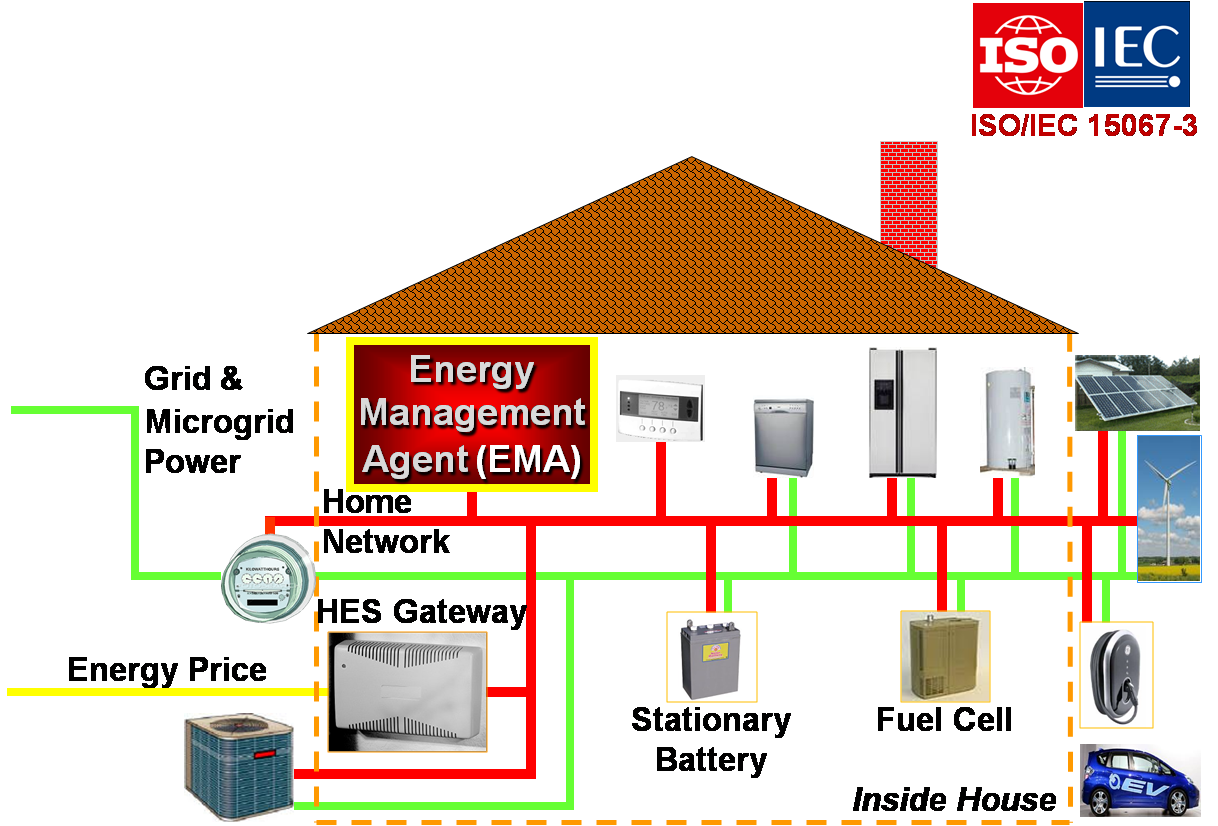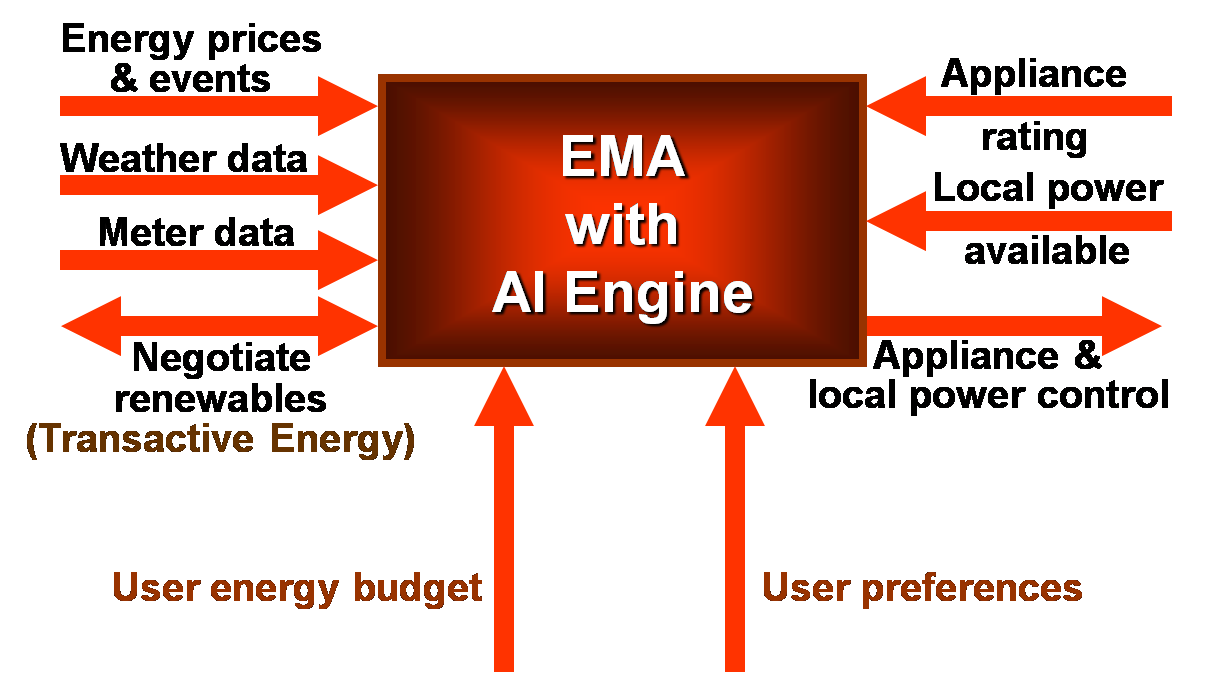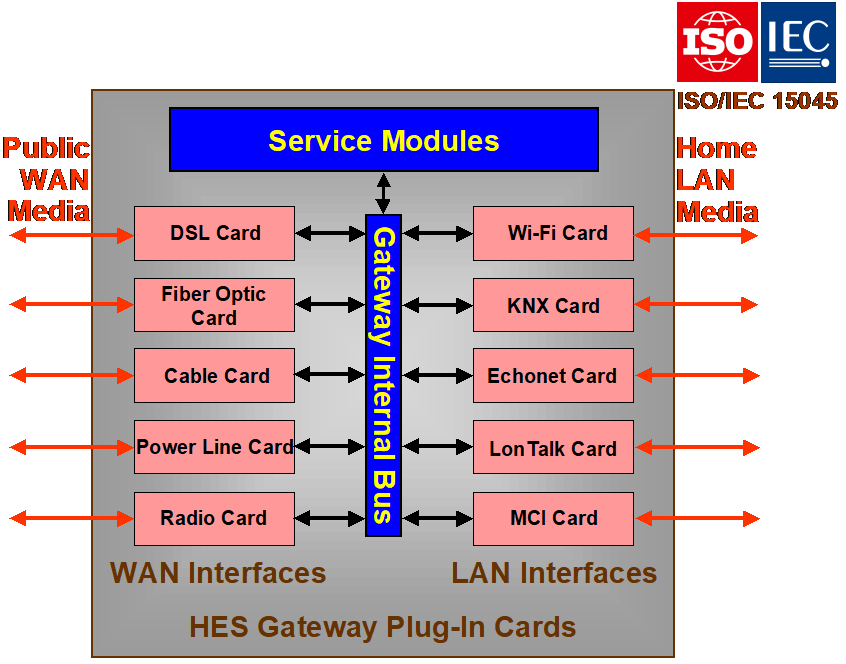This is the ninth article in a series that premiered in November 2021 on international standards for energy management. These standards support the transformation of the power grid from centralized generation to distributed energy resources including local solar, wind, and stored energy in homes and buildings.
 These are voluntary industrial standards developed to promote world trade by a committee I chair for ISO1 and IEC2. They are part of a family of standards for interconnected consumer electronics (home automation) called the “Home Electronic System” (HES)3. I welcome your comments and participation in developing these standards; please visit kenwacks.com for contact data.
These are voluntary industrial standards developed to promote world trade by a committee I chair for ISO1 and IEC2. They are part of a family of standards for interconnected consumer electronics (home automation) called the “Home Electronic System” (HES)3. I welcome your comments and participation in developing these standards; please visit kenwacks.com for contact data.
The Business Case for Energy Management
This series of ASHB Journal articles on user-centric energy management has introduced the international standards developed for the Energy Management Agent (EMA, ASHB Journal issue of December 20214). The EMA, illustrated in Figures 1 and 2, uses elements of artificial intelligence (AI) and automation to help the user optimize energy consumption and production from solar panels and wind turbines at homes and from external sources. All this technology depends on motivating appliance and consumer electronics companies to design, build, and market EMAs plus the supporting interface equipment and software specified by these standards. This article examines the profound changes in the energy industry this century and business opportunities to participate profitably in this transformation.

Figure 1 – Energy Management Agent (EMA)
(ISO/IEC 15067-3, Information technology – Home Electronic System (HES) application model – Part 3: Model of a demand-response energy management system for HES)

Figure 2 – Energy Management Agent (EMA) inputs & outputs
Implementing HES energy management standards
The HES standards are all voluntary. They are intended to promote trade by offering a common infrastructure upon which applications may be developed. Manufacturers don’t need to invest development costs and time into proprietary infrastructures. Instead, they can focus resources on innovative applications and user experiences.
The HES family of standards is designed as a pragmatic solution for the competitive world of consumer electronics. Manufacturers who adopt HES have choices for energy management strategies and implementation options ranging from stand-alone products to co-located services, as discussed in this article.
The list of HES standards for energy management is expected to expand as practical implementations of the EMA are introduced and evolve. Proposals have been discussed for:
- Interactions between an EMA and:
– A smart meter
– A smart inverter
– Smart appliances
– Appliances with smart-plug interfaces - Extensions of the EMA protocol for additional networked devices
- An expanded data model for the EMA protocol
- A discovery process for organizing a campus of EMAs
- AI that facilitates EMA adaptation to power sources, loads, and constraints
From incremental to fundamental changes
As electricity became widely adopted a century ago, public utilities were able to generate sufficient supplies to meet nearly all customer demands for electricity. Twentieth-century power was usually available, but at a financial and environmental cost. There is a movement in the 21st century away from centralized power generation based on fossil fuels toward renewable power sources located close to the user. As some customers have experienced, central generation has limitations in resiliency in the face of super storms and cybersecurity threats.
Renewable sources vary with the weather and time of day. However, renewable power will become more stable and predictable with the development of low-cost storage equipment and microgrids to distribute renewable power locally within a community. The EMA is an important automation tool for homes and buildings to provide electricity service that is nearly equivalent in availability to 20th century power, but without the environmental impacts.
Market opportunities for consumer electronics companies
Energy management systems that include EMAs designed according the HES standards are important additions to an intelligent home. Who might build and sell EMAs and related equipment? We are evolving from utility-furnished energy management equipment based on direct load control to consumer-purchased energy management appliances and controllers. Devices specified by utilities to support demand management programs for direct load control of HVAC and water heaters are purpose-built low-volume products installed by utility contractors to deliver a service. They are generally not intended to be sold as attractive products at retail.
As consumers adopt local energy sources, energy management moves from the utility to the consumer domain. Consumer electronics manufacturers can become important players in this space. However, they need a solid business case for investing in energy management. Consumer electronics have never constituted a major portion of residential electric bills. Furthermore, consumer electronics makers have responded well to pressures for improving energy efficiency and lowering standby power consumption.
Between 2003 and 2010 power consumption in LCD digital TVs dropped 63% when operating. Standby power required for a TV to respond to a remote-control turn-on command is now less than one Watt. This expertise in enhancing energy efficiency can be extended to energy management by co-locating EMA features within consumer electronics controllers. How can consumer electronics companies be motivated to develop products featuring energy management?
Consumer electronics companies might seize upon the deficiencies in product and market development for traditional demand response and help create new product features to expand the market for energy management. Consumer electronics companies know product design, value engineering, high volume distribution, and customer support. Where specialized technology is needed for energy management products, consumer electronics makers might buy energy-related equipment manufacturers to acquire such technology.
The HES Gateway platform for applications
A new business opportunity afforded by the HES standards is the HES Gateway. As I explained in previous articles, the HES Gateway offers more than a communications protocol translator. It provides interoperability and cybersecurity services. We are now developing standards to extend the HES Gateway to provide a platform for applications by serving as a home automation hub. It is flexible to accommodate multiple public networks (WANs: Wide Area Networks) and private networks (LANs: Local Area Networks) in homes, shown in Figure 3.

Figure 3 – HES Gateway structure
As described in ISO/IEC TR 14543-45 and the ISO/IEC 10192-4 series6, home automation applications usually are developed as interconnected appliances and systems to provide a specific set of services such as lighting, security, entertainment, healthcare, or energy management. These services are enabled by components that typically include sensors, actuators, user interfaces, and a controller that processes data from the other components. Manufacturers complying with HES standards have considerable latitude about how to design applications and where to locate the components. In a home system they have the flexibility of interconnecting the components via a HAN (home area network, which is a LAN in a house).
The HES Gateway can provide the following platform functions. If a manufacturer chooses to locate the application controller within the HES Gateway, these services are readily available for optimum performance.
- Multiple HAN and WAN interfaces
- Communications between a HAN and WAN
- Interoperability among HAN devices running different communication protocols
- Protection of customer data, privacy, and safety
- Application service modules
The concept of an application platform in the HES Gateway is specified in ISO/IEC 15045-5-17. This platform is intended to encourage the development of independent open-source application software (i.e., plug-in apps) to support network interface modules and application service agents for existing and new appliances, products, and functions. We anticipate that HES Gateway developers can draw from an expanding library of apps.
The HES Gateway platform for energy management
ISO/IEC 15045-5-28 enables the HES Gateway to host the EMA and an energy measurement system (called EMMA: Energy Management and Measurement Application) including power measurements from local generation and storage devices. As noted in ISO/IEC 15067-3-39, multiple EMAs in apartments, buildings, and a campus complex may interact with an EMA in the cloud. The terms Premises EMA (PEMA) and Cloud EMA (CEMA) are introduced to distinguish these EMAs by location.
An implementation of an EMA on premises (a PEMA) may be located in an HES Gateway as an application service module with convenient access to the other gateway services. This may be beneficial since the PEMA could use the HAN interoperability functions to communicate with local energy sources, EV chargers, stationary batteries, and appliances that consume significant power.
The HES Gateway platform approach to managing premises energy is to divide the management process into modular task-oriented services and assign them to application service modules. Each service module is focused on a specific task or set of tasks, depending on the resources available in a home or building (such as sensors, actuators, appliances, thermostats, etc.) or on the desired applications. A service module obtains access to premises sensors, actuators, end appliances, and other service agents via the HES Gateway platform services including those for protecting privacy (such as energy consumption data), cybersecurity, and safety.
Marketing skills applied to energy products
Consumer electronics companies might enhance existing products by adding energy management functions or develop purpose-built products such as the EMA or the HES Gateway. In either case, they can apply expertise in product innovation and market development to exploit the energy management market. A primary driver for innovation is the potential for generating sales in existing or new markets such as premises-based distributed energy resources (DER: solar panels, wind turbines, and storage batteries), Transactive Energy, and microgrids.
Energy management is not an attention-grabbing application for consumer expenditures. However, consumer electronics companies know how to market products that appeal to consumers with entertainment features and clever designs. Therefore, these companies might be able to help suppliers of energy products and services make product offerings more attractive by addressing issues such as:
- Product design
- User interface
- Automatic installation and provisioning
- Convenience
- Portability
- Adaptability to customer demographics
- Platform for multiple applications
- Remote service capabilities
As computer electronics companies know well, the channels to market and the accompanying customer support systems are essential for reaching, maintaining, and growing a market. Consumer electronics companies are masters at understanding the customer and adapting to a fickle audience. Whereas a utility will typically deploy a demand response program that may offer two options, such as water-heater or air-conditioner control, a consumer electronics vendor has a dozen varieties of TV sizes and features. Consumer electronics companies quickly learn which lines to abandon and which will bring in profits.
Electric vehicles (EVs) are starting to gain market share. The infrastructure for charging at home, at work, in garages, and throughout cities and highways is being addressed gradually. Consumer preferences for charging station locations and methods will depend on customer conveniences. Most EVs are charged at home. Consumer electronics companies could integrate EV charging equipment with home networks as part of residential energy management.
Accommodating energy management
Consumer electronics now being designed with Internet access, such as smart TVs and DVRs (digital video recorders), might include headroom in controllers and memory for new applications and support for software upgrades. As more products include such capabilities, energy management could be programmed into interconnected consumer electronics devices. Interconnection moves the traditional developer of a product-in-a-box (all features and components of an appliance contained in one cabinet) into the realm of systems. This is undoubtedly challenging to established business practices, but may open new markets and product extensions.
Home automation companies and start-ups are introducing products for consumers to adapt to energy management programs. Many of the global consumer electronics companies have not yet entered this market. Although these products are in the energy field, which is not a focus of consumer electronics companies, the parameters for market success are the same:
- Packaging and pre-sales support
- User experience and ease of use
- Consumer benefits
- Price points
- Installation convenience
Energy management is becoming a practical adjunct to consumer electronics products. Integrating energy management into a diversity of products may help us move toward renewable power sources and mitigate our impact on climate change.
1. ISO is the International Organization for Standardization, founded in 1947, www.iso.org.
2. IEC is the International Electrotechnical Commission, founded in 1906, www.iec.ch.
Both ISO and IEC are headquartered in Geneva, Switzerland.
3. The Home Electronic System (HES) is the name of the international standards committee officially designated as ISO/IEC JTC 1/SC 25/WG 1:
JTC 1 = Joint Technical Committee 1, entitled Information Technology
SC 25 = Subcommittee 25, entitled Interconnection of Information Technology Equipment
WG 1 = Working Group 1, entitled Home Electronic System
4. https://www.ashb.com/ken-wacks-perspectives-shifting-energy-management-from-utilities-to-users/
5. ISO/IEC TR 14543-4, Information Technology – Home Electronic System (HES) architecture – Part 4: Home and building automation in a mixed-use building
6. ISO/IEC 10192-4-1, Information Technology – Home Electronic System (HES) interfaces – Part 4-1: Common user interface to support interworking among home cluster systems – Architecture
ISO/IEC 10192-4-2, Information Technology – Home Electronic System (HES) interfaces – Part 4-2: Common user interface to support interworking among home cluster systems – Interfaces, services and objects [In progress]
ISO/IEC 10192-4-3, Information Technology – Home Electronic System (HES) interfaces – Part 4-2: Common user interface to support interworking among home cluster systems – Messaging [In progress]
7. ISO/IEC 15045-5-1, Information Technology – Home Electronic System (HES) gateway – Part 5-1: HES Gateway application services [In progress]
8. ISO/IEC 15045-5-2, Information Technology – Home Electronic System (HES) gateway – Part 5-2: Energy management and measurement application (EMMA) [In progress]
9. ISO/IEC 15067-3-3:2019, Information technology – Home Electronic System (HES) application model – Part 3-3: Model of a system of interacting Energy Management Agents (EMAs) for demand response energy management
© Copyright 2024 Kenneth P. Wacks
Dr. Ken Wacks has been a pioneer in establishing the home systems industry and a management advisor to clients worldwide. His business specialties include IoT (Internet of Things), cybersecurity, standards for home and building systems, AI-based energy management including renewables, and digital media networks. He also provides due-diligence for investors and expert witness services for litigants including patent, employment non-compete, and trade secret cases. Please visit kenwacks.com or contact Ken at +1 781 662-6211; [email protected]; www.kenwacks.com.


